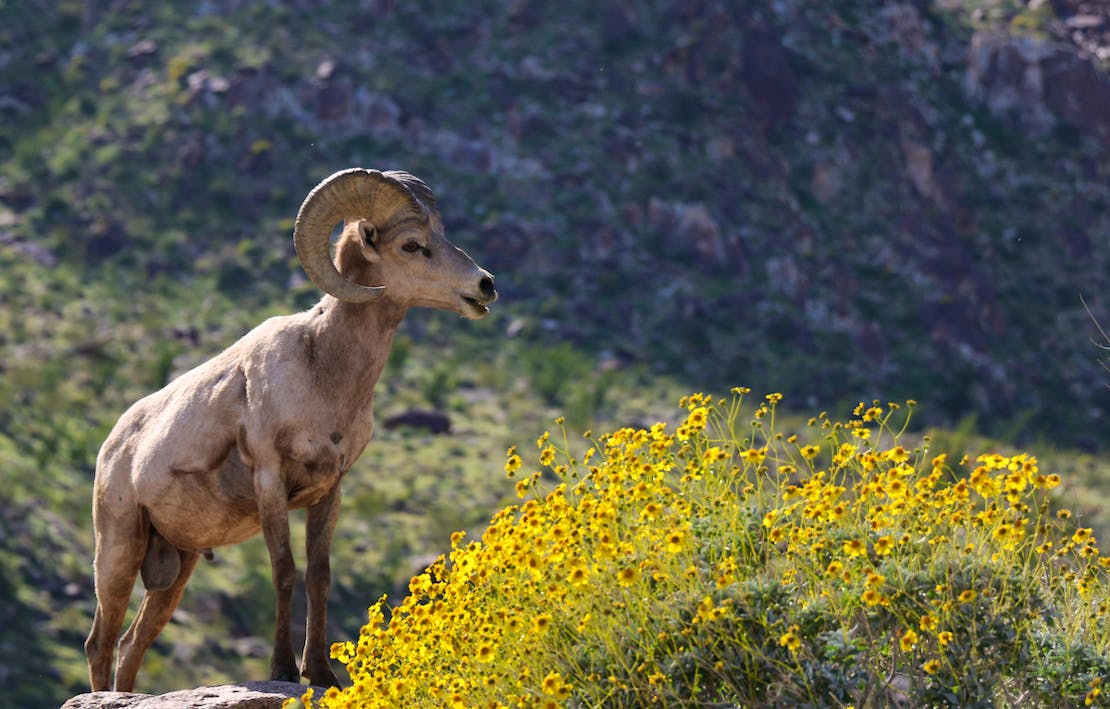Join our mobile Rapid Response Network!
You can be the first to hear about how we’re going to hold this administration accountable and how you can fight back for wildlife!
Bighorn sheep get their name from the large, curved horns on the males, or rams; with female sheep sporting shorter, less curved horns.
Legendary for their ability to climb high, steep, rocky mountain areas, various bighorn subspecies and a distinct population (i.e., Peninsular) occur in the western United States. Virtually all mountain ranges in the Southwest, as well as the Sierra Nevada and Rocky Mountain Ranges, once supported large bighorn sheep populations – including most if not all mountain ranges forming what is referred to as a “meta-population” within the California Desert.
Competition with domestic livestock for forage, loss of water sources from human diversion or livestock use, mining operations, vehicle collisions on highways, military bombing on training ranges and the spread of several diseases introduced by domestic livestock have devastated bighorn sheep populations throughout the West. Numerous individual mountain ranges no longer support bighorn populations and major Interstate highways have cut off once-connected mountain ranges. Fortunately, historic overhunting is no longer an issue due to successful state laws and regulations that allow for regulated hunting in a manner that sustains bighorn sheep populations.
Competition with domestic livestock for forage and water, disease transmission from domestic livestock, collision mortality associated with highways, military bombing on training reservations, herbicide/insecticides/fatal plants on golf courses, climate change increasing temperatures and decreasing rainfall, and habitat loss associated with housing and recreational vehicle use in increasingly steep terrain (including lambing habitat) are continuing to devastate bighorn sheep populations.
Peninsular bighorn sheep and Sierra Nevada bighorn sheep are endangered

Defenders' Impact
Defenders is urging the United States Air Force to back away from its heavy-handed attempt to usurp most of the Desert National Wildlife Refuge in Nevada and to pursue a more collaborative approach that fairly balances wildlife conservation, cultural resource protection and military training on these public lands.
We are also working to protect other public lands and wildlife corridors across the region that support bighorn sheep populations in a variety of planning processes that address livestock grazing, recreational vehicle use, new remote housing developments, highway modification/expansion and groundwater mining.
The goal of the Desert Renewable Energy Conservation Plan (DRECP), a massive data collection and collaborative effort among state and federal agencies, as well as other stakeholders in the California Desert, including Defenders, was to identify suitable sites for much-needed renewable-energy project development; while at the same time ensuring that important wildlife, wilderness and recreational areas are managed appropriately according to state and federal law.
Defenders has also partnered with numerous non-governmental organizations to review all application of the DRECP on a regular basis. Further, Defenders has developed and advocates for “Smart from the Start” renewable energy facility location siting, to protect at-risk wildlife and their habitats.
What You Can Do
Voice your support for appropriate public, park and private land management that protects bighorn, particularly in mountain ranges within our public lands that have been designated National Conservation Lands, National Monuments and National Wildlife Refuges. Oppose expanding the incredibly large Nellis Air Force Base at the expense of the largest desert bighorn populations in the nation, at the Desert National Wildlife Refuge.

About
Rocky Mountain bighorn occupy the precipitously steep terrain of the Rocky Mountains and Pacific Northwest. Sierra Nevada bighorn occur in the Sierra Nevada Mountains of California. Desert bighorn sheep, including Peninsular bighorn sheep, occur throughout the desert regions of the Southwest and Mexico.
There are fewer than 70,000 bighorn sheep in North America. The Sierra Nevada bighorn sheep and Peninsular bighorn sheep populations each number about 600.
Bighorn sheep live in herds or bands of about 5 to 15 ewes, lambs, yearlings, and juveniles. Groups of males are much smaller, usually numbering two to five. In the winter, the ewe herds join to create bands of as many as 100 animals. In the fall, rams compete for ewes by having head-butting contests. They charge each other at speeds of more than 20 mph, their foreheads crashing with a crack that can be heard more than a mile away. Older rams exhibit considerable horn damage after a few years of these contests
Lambs are born with a soft, woolly, light-colored coats and small horn-buds. Within a day, a lamb can walk and climb as well as its mother. A lamb will stay with its mother for the first year of its life.
Mating Season: November and December
Gestation: 5-6 months
Offspring: 1 lamb
During the summer, bighorn forage on grasses or sedges, and in the desert regions, barrel cactus. During the winter bighorn feed more on woody plants, such as willow, sage and rabbit brush.
Read More About the Bighorn Sheep
News









